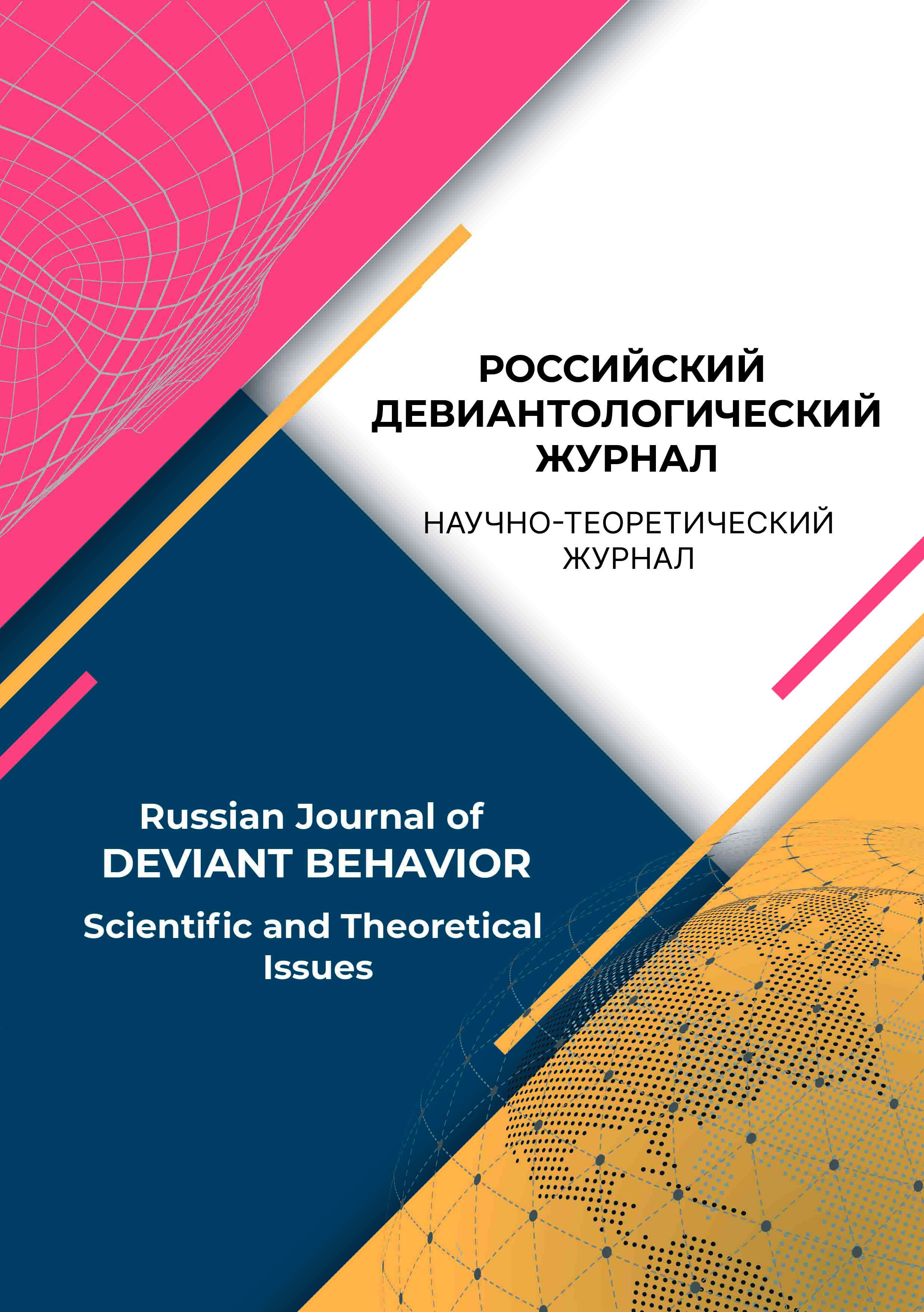UDC 159.9
UDC 316.624
Introduction. Criminalisation negatively affects the well-being of society and personality, worsening and restricting progress and hindering their functioning and development. Scientific ideas about criminalisation are based on the regulations of individually-psychological and social approaches. The possibilities of the subjective approach are not fully used to study criminalisation, but they are useful, as they can reveal subjective components of the determination and regulation of criminal behavior. The development of subjective approach within the framework of research allows us to substantiate theoretically the combination of relations involved in regulation of behavior and to develop a model of these relations for assessing risk of criminalisation. The aim of study is a theoretical substantiation of set of subjective relations indicating a risk of personality criminalisation and its empirical verification. For this purpose, the study examines a model of personality attitudes affecting its criminalisation, having developed on the basis of theoretical analysis of domestic and foreign researchers' ideas about criminogenic personality, criminogenic orientation and regulation of criminal behavior. Methodology, methods and techniques. The methodological basis of the study is a subjective approach (S.L. Rubinstein, A.V. Brushlinsky, K.A. Abulkhanova), value-normative theory of criminal behavior (A.R. Ratinov), provisions about criminogenic propensity of personality (A.N. Pastushenya). The empirical study is aimed at verifying the interconnection of subjective attitudes indicating the criminalisation of personality. The method of collecting data is the questionnaire "Risk of Criminalisation", the structure of which is formed by five scales which totally include 60 questions. The method of processing results: descriptive statistics, confirmatory factor analysis, nonparametric criterion of differences Kruskal-Wallis-H criteria test. The study sample: 618 people divided into law-abiding (n=202 people) and criminogenic group, having been divided in its turn by the criterion of repeated criminal responsibility into subgroups of situation-criminogenic persons (n=219 people) and consecutive-criminogenic persons (n=197 people). The criminogenic persons were administratively supervised by law enforcement bodies of the Russian Federation. Results: criminalising significance of subjective attitudes set of super-valuable attitude to the self, devaluing attitude to punishment and cynically accusing attitude to the victim was confirmed. As a result of confirmatory factor analysis, an adjusted scale suitable for assessing the risk of criminalisation was obtained, and some information about its reliability and validity was obtained.
criminalisation of personality, psychology of crime, attitude to crime, diagnosis of criminal personality, criminogenic personality
1. Alekseeva, L. V. (2006). Psihologicheskaya harakteristika sub"ekta prestupleniya: avtoref. dis. … d. psihol. nauk. Saint Petersburg.
2. Bastrykin, A. I., Sal'nikov, V. P., Romanovskaya, V. B., Voronkov, K. I. (2020). Antikriminogennaya resocializaciya: zarubezhnyj opyt. Vserossijskij kriminologicheskij zhurnal, 14 (3), 371-378. https://doi.org/10.17150/2500- 4255.2020.14(3).371-378
3. Bogdanova, E. A., Gubin, V. A. (2019). Osobennosti psihologicheskih zashchit u lic srednego vozrasta v usloviyah social'noj izolyacii. Problemy sovremennogo pedagogicheskogo obrazovaniya, 65 (2), 306-309.
4. Vetra, A. V. (2020). Ob osobennostyah samootnosheniya nesovershennoletnih podozrevaemyh, obvinyaemyh i osuzhdennyh. Vestnik Barnaul'skogo yuridicheskogo instituta MVD Rossii, 1 (38), 204-205.
5. Grigor'eva, A. A., Afonina, Yu. S., Kabanova, T. N. (2018). Kriminalizaciya nesovershennoletnih kak problema sovremennogo obshchestva (psihologicheskie, social'no-psihologicheskie i kliniko-psihopatologicheskie faktory). Prikladnaya yuridicheskaya psihologiya, 4 (45), 49-59.
6. Dvoryanchikov, N. V., Savkina, I. A. (2011). Issledovanie osobennostej pravosoznaniya nesovershennoletnih. Psihologicheskaya nauka i obrazovanie, 3 (1). URL: https://psyjournals.ru/journals/psyedu/archive/2011_n1/39933
7. Debol'skij, M. G., Levin, L. M., Bokova, N. V. (2016). Sravnitel'nyj analiz sub"ektivnoj kartiny zhiznennogo puti osuzhdennyh, sostoyashchih na uchete v ugolovno - ispolnitel'noj inspekcii. Psihologiya i pravo, 6 (4), 186-195. https://doi. org/10.17759/psylaw.2016060417
8. Zautorova, E. V., Kevlya, F. I. (2021). Osobennosti psihologicheskoj zashchity osuzhdennyh, nahodyashchihsya v mestah lisheniya svobody. Psihopedagogika v pravoohranitel'nyh organah, 26 (4 (87)), 398-403. https://doi. org/10.24412/1999-6241-2021-487-398-403
9. Zlokazov, K. V., Il'yankova, E. I., Rozhkov, A. A. (2021). Vliyanie predstavleniya o social'nom prostranstve na ocenku prestupleniya nesovershennoletnimi. Vserossijskij kriminologicheskij zhurnal, 15 (1), 15-26. https://doi. org/10.17150/2500-4255.2021.15(1).15-26
10. Zlokazov, K. V. (2023). Ocenka lichnostnyh, mezhlichnostnyh i social'nyh problem v resocializacii lic, privlekavshihsya k ugolovnoj otvetstvennosti. Vestnik Sankt-Peterburgskogo universiteta MVD Rossii, 3 (99), 218-226. https://doi.org/10.35750/2071-8284-2023-3-218-226
11. Makarkina, O. E. (2019). Samoopravdanie osuzhdennyh kak faktor, prepyatstvuyushchij ih ispravleniyu. V Ugolovno-ispolnitel'naya sistema: realii i perspektivy razvitiya: materialy Mezhdunarodnoj zaochnoj nauchno-prakticheskoj konferencii (Pskov, 31 maya 2019 goda, str. 171-175). Pskov: Pskovskij filial Akademii prava i upravleniya Federal'noj sluzhby ispolneniya nakazanij.
12. Nedil'ko, M. S., Zlokazov, K. V. (2020). Razlichiya v sub"ektivnyh predstavleniyah byvshih sotrudnikov pra-voohranitel'nyh organov, osuzhdyonnyh za sovershenie korystnyh i korrupcionnyh prestuplenij. Vestnik Sankt-Peterburgskogo universiteta MVD Rossii, 2 (86), 215-222. https://doi.org/10.35750/2071-8284- 2020-2-215-222
13. Pastushenya, A. N. (2011). Psihologicheskij mekhanizm prestupnogo povedeniya: sistemno-funkcional'nyj analiz. Prikladnaya yuridicheskaya psihologiya, 1, 27-38.
14. Pastushenya, A. N. (1998). Kriminogennaya sushchnost' lichnosti prestupnika: metodologiya poznaniya i psihologicheskaya koncepciya. Minsk: Akademiya MVD Respubliki Belarus'.
15. Pastushenya, A. N. (2012). Harakteristika sistemoobrazuyushchego yadra kriminogennoj sklonnosti lichnosti. Prikladnaya yuridicheskaya psihologiya, 2, 18-28.
16. Ratinov, A. R. (2016). Izbrannye trudy. Seriya Nauchnye trudy uchenyh Akademii General'noj prokuratury Rossijskoj Federacii. Moskow: Akademiya General'noj prokuratury Rossijskoj Federacii.
17. Ratinov, A. R. (2009). Lichnost' prestupnika. Psihologicheskie aspekty. V Yuridicheskaya psihologiya: sbornik nauchnyh trudov (vyp. 4, str. 7-16). Moskow: Akademiya General'noj prokuratury Rossijskoj Federacii.
18. Romanova, N. M. (2015). Raznovidnosti vovlecheniya lichnosti v kriminal'nuyu deyatel'nost'. Izvestiya Saratovskogo universiteta. Novaya seriya. Seriya Filosofiya. Psihologiya. Pedagogika, 15 (3), 96-100.
19. Rubinshtejn, S. L. (1989). Osnovy obshchej psihologii: v 2 t. T. II. Trudy dejstvitel'nyh chlenov i chlenov-korrespondentov Akademii pedagogicheskih nauk SSSR. Moskow: Pedagogika.
20. Sergienko, E. A., Vilenskaya, G. A., Kovaleva, Yu. V. (2010). Kontrol' povedeniya kak sub"ektnaya regulyaciya. Moskow: Institut psihologii RAN.
21. Suchkova, E. L. (2018). Koncepciya issledovaniya psihologii gruppovogo pravosoznaniya osuzhdennyh. Psihologiya i pravo, 8 (2), 101-112. https://doi.org/10.17759/psylaw.201808020
22. Tazin, I. I. (2006). Kriminalisticheskaya harakteristika motivacionno - smyslovoj sfery lichnosti prestupnika: avtoref. dis. … kand. yurid. nauk. Tomsk.
23. Tokareva, G. M. (2017). Individual'no-psihologicheskie i kliniko-social'nye harakteristiki lic s psihicheskimi rasstrojstvami v zavisimosti ot haraktera kriminal'noj recidivnosti. Psihologiya. Istoriko-kriticheskie obzory i sovremennye issledovaniya, 6 (5A), 83-91.
24. Uzlov, N. D. (2015). Prigovorennye k zhizni: samoocenka agressivnosti i chuvstva viny osuzhdennymi k pozhiznennym srokam lisheniya svobody. Suicidologiya, 6 (1 (18)), 42-53.
25. Urazaeva, G. I. (2014). Metodologicheskie principy izucheniya lichnosti prestupnika i prestupnogo povedeniya. Vestnik Kazanskogo yuridicheskogo instituta MVD Rossii, 3 (17), 126-130.
26. Chernysheva, E. V. (2007). Faktornaya struktura Ya-koncepcii lichnosti osuzhdennyh. Psihopedagogika v pravoohranitel'nyh organah, 4 (31), 40-47.
27. Althoff, M., Dollinger, B., & Schmidt, H. (2020). Fighting for the “Right” Narrative: Introduction to Conflicting Narratives of Crime and Punishment. In: Althoff, M., Dollinger, B., Schmidt, H. (Eds.), Conflicting Narratives of Crime and Punishment. Palgrave Macmillan, Cham. https://doi.org/10.1007/978-3-030-47236-8_1
28. Byrne, B. M. (2016). Structural equation modeling with AMOS: Basic concepts, applications, and programming (3rd Ed.). New York: Routledge.
29. De Vel-Palumbo, M., Wenzel, M., & Woodyatt, L. (2019). Self-punishment promotes reconciliation with third parties by addressing the symbolic implications of wrongdoing. European Journal of Social Psychology, 49 (5), 1070-1086. https://doi.org/10.1002/ejsp.2571
30. Deitzer, J. R., Leban, L., Copes, H., & Wilcox, S. (2022). Criminal Self-Efficacy and Perceptions of Risk and Reward among Women Methamphetamine Manufacturers. Justice Quarterly, 39 (4), 847-870. https://doi.org/10.1080/0741882 5.2021.1901965
31. Gummerum, M., Hanoch, Y., & Rolison, J. J. (2014). Offenders' risk-taking attitude inside and outside the prison walls. Risk analysis: an official publication of the Society for Risk Analysis, 34 (10), 1870-1881. https://doi.org/10.1111/ risa.12222
32. Hall, J. H., & Fincham, F. D. (2008). The temporal course of self-forgiveness. Journal of Social & Clinical Psychology, 27 (2), 174-202. https://doi.org/10.1521/jscp.2008.27.2.174
33. Haynes, S. H., & Cares, A. C. (2015). Victims’ and Offenders’ Views About Crime and Justice. Sociological Focus, 48 (3), 228-248. http://www.jstor.org/stable/24579296
34. Ioannou, M., Canter, D., Youngs, D., & Synnott, J. (2015). Offenders’ Crime Narratives Across Different Types of Crimes. Journal of Forensic Psychology Practice, 15 (5), 383-400. https://doi.org/10.1080/15228932.2015.1065620
35. Levy, I., & Ben-David, S. (2015). Mechanism of Bystander-Blaming: Defensive Attribution, Counterfactual Thinking, and Gender. International Journal of Offender Therapy and Comparative Criminology, 59 (1), 96-113. https://doi. org/10.1177/0306624X13503297
36. Walters, G. D. (1995). The psychological inventory of criminal thinking styles: Part I: Reliability and preliminary validity. Criminal Justice and Behavior, 22 (3), 307-325. https://doi.org/10.1177/0093854895022003008.
















